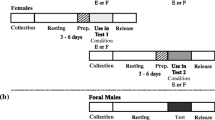Abstract
Using a sample of 652 college students, we examined several implications of the hypothesis that the shape of the human penis evolved to enable males to substitute their semen for those of their rivals. The incidence of double mating by females appears sufficient to make semen displacement adaptive (e.g., one in four females acknowledge infidelity, one in eight admit having sex with two or more males in a 24-hour period, and one in 12 report involvement in one or more sexual threesomes with two males). We also document several changes in post-ejaculatory behavior (e.g., reduced thrusting, penis withdrawal, loss of an erection) which may have evolved to minimize displacement of the male’s own semen. Consistent with predictions derived from a theoretical model (Gallup and Burch 2006), we discovered that most females report waiting at least 48 hours following an instance of infidelity before resuming sex with their in-pair partners.
Similar content being viewed by others
References
Anderson, K. G. 2006 How Well Does Paternity Confidence Match Actual Paternity? Results from Worldwide Nonpaternity Rates. Current Anthropology 48:511–518.
Appell, R. A., P. R. Evans, and J. P. Blandy 1997 The Effect of Temperature on the Motility and Viability of Sperm. British Journal of Urology 49:751–756.
Baker, R. R., and M. A. Bellis 1995 Human Sperm Competition: Copulation, Masturbation, and Infidelity. London: Chapman and Hall.
Burch, R. L., and G. G. Gallup, Jr. 2004 Pregnancy: A Stimulus for Domestic Violence? Journal of Family Violence 19:243–247.
Buss, D. M. 2002 Human Mate Guarding. Neuroendocrinology Letters 23(Suppl. 4):23–29.
Busse, C. D., and D. Q. Estep 1984 Sexual Arousal in Male Pigtailed Monkeys (Macaca nemestrina): Effects of Serial Matings by Two Males. Journal of Comparative Psychology 98:227–231.
Daly, M., M. Wilson, and S. Weghorst 1982 Male Sexual Jealousy. Ethology and Sociobiology 3:11–27.
Douglas, K. A., J. L. Collins, C. Warren, L. Kann, R. Gold, S. Clayton, J. G. Ross, and L. J. Kolbe 1997 Results from the 1995 National College Health Risk Behavior Survey. Journal of American College Health 46:55–66.
Gallup, G. G. Jr., and R. L. Burch 2004 Semen Displacement as a Sperm Competition Strategy. Evolutionary Psychology 2:12–23.
2006 The Semen Displacement Hypothesis: Semen Hydraulics and the Intra-Pair Copulation Proclivity Model of Femal Infidelity. In Female Infidelity and Paternal Uncertainty. Steven M. Platek and Todd K. Shackelford, eds. Pp. 129–140. Cambridge: Cambridge University Press.
Gallup, G. G. Jr., R. L. Burch, M. Zappieri, R. Parvez, M. Stockwell, and J. A. Davis 2003 The Human Penis as a Semen Displacement Device. Evolution and Human Behavior 24:277–289.
Goetz, A. T., and T. K. Shackelford 2006 Sexual Coercion and Forced In-Pair Copulation as Sperm Competition Tactics in Humans. Human Nature 17:265–282.
Goetz, A. T., T. K. Shackelford, V. A. Weekes-Shackelford, H. A. Euler, S. Hoier, D. P. Schmitt, and C. W. LaMunyon 2005 Mate Retention, Semen Displacement, and Human Sperm Competition: A Preliminary Investigation of Tactics to Prevent and Correct Female Infidelity. Personality and Individual Differences 38:749–763.
Laumann, E. O., J. H. Gagnon, R. T. Michael, and S. Michaels 1994 The Social Organization of Sexuality: Sexual Practices in the United States. Chicago: University of Chicago Press.
Makler, A., M. Deutch, A. Vilensky, and Y. Palti 1981 Factors Affecting Sperm Mobility, VIII: Velocity and Survival of Human Spermatozoa as Related to Temperatures above Zero. Journal of Andrology 4:559–569.
Platek, S. M., S. R. Critton, R. L. Burch, D. A. Frederick, T. S. Myers, and G. G. Gallup, Jr. 2003 How Much Resemblance Is Enough? Determination of a Just Noticeable Difference at which Male Reactions towards Children’s Faces Change from Indifferent to Positive. Evolution and Human Behavior 23:81–87.
Poulson, R. L., M. A. Eppler, T. N. Satterwhite, K. L. Wuensch, and L. A. Bass 1998 Alcohol Consumption, Strength of Religious Beliefs, and Risky Sexual Behavior in College Students. Journal of American College Health 46:227–333.
Shackelford, T. K. 2003 Preventing, Correcting, and Anticipating Female Infidelity. Evolution and Cognition 9:1–7.
Shackelford, T. K., N. Pound, and A. T. Goetz 2005 Psychological and Physiological Adaptations to Sperm Competition in Humans. Review of General Psychology 9:228–248.
Smith, R. L. 1984 Human Sperm Competition. In Sperm Competition and the Evolution of Animal Mating Systems, R. L. Smith, ed. Pp. 601–660. New York: Academic Press.
Tutin, C. E. G. 1979 Mating Patterns and Reproductive Strategies in a Community of Wild Chimpanzees. Behavioral Ecology and Sociobiology 6:29–38.
Weinberg, M. S., I. L. Lottes, and F. M. Shaver 1995 Swedish or American Heterosexual College Youth: Who Is More Permissive? Archives of Sexual Behavior 24:409–437.
Author information
Authors and Affiliations
Corresponding author
Additional information
Gordon G. Gallup, Jr. is a professor of psychology interested in human reproductive competition.
Rebecca L. Burch is an associate professor of psychology interested in familial and social relationships, semen biochemistry, semen displacement, and other sexual behaviors. Tracy J. Berens Mitchell is currently a graduate student in the Human Sexuality Program at Widener Univeristy.
Rights and permissions
About this article
Cite this article
Gallup, G.G., Burch, R.L. & Mitchell, T.J.B. Semen displacement as a sperm competition strategy. Hum Nat 17, 253–264 (2006). https://doi.org/10.1007/s12110-006-1008-9
Received:
Revised:
Accepted:
Issue Date:
DOI: https://doi.org/10.1007/s12110-006-1008-9




